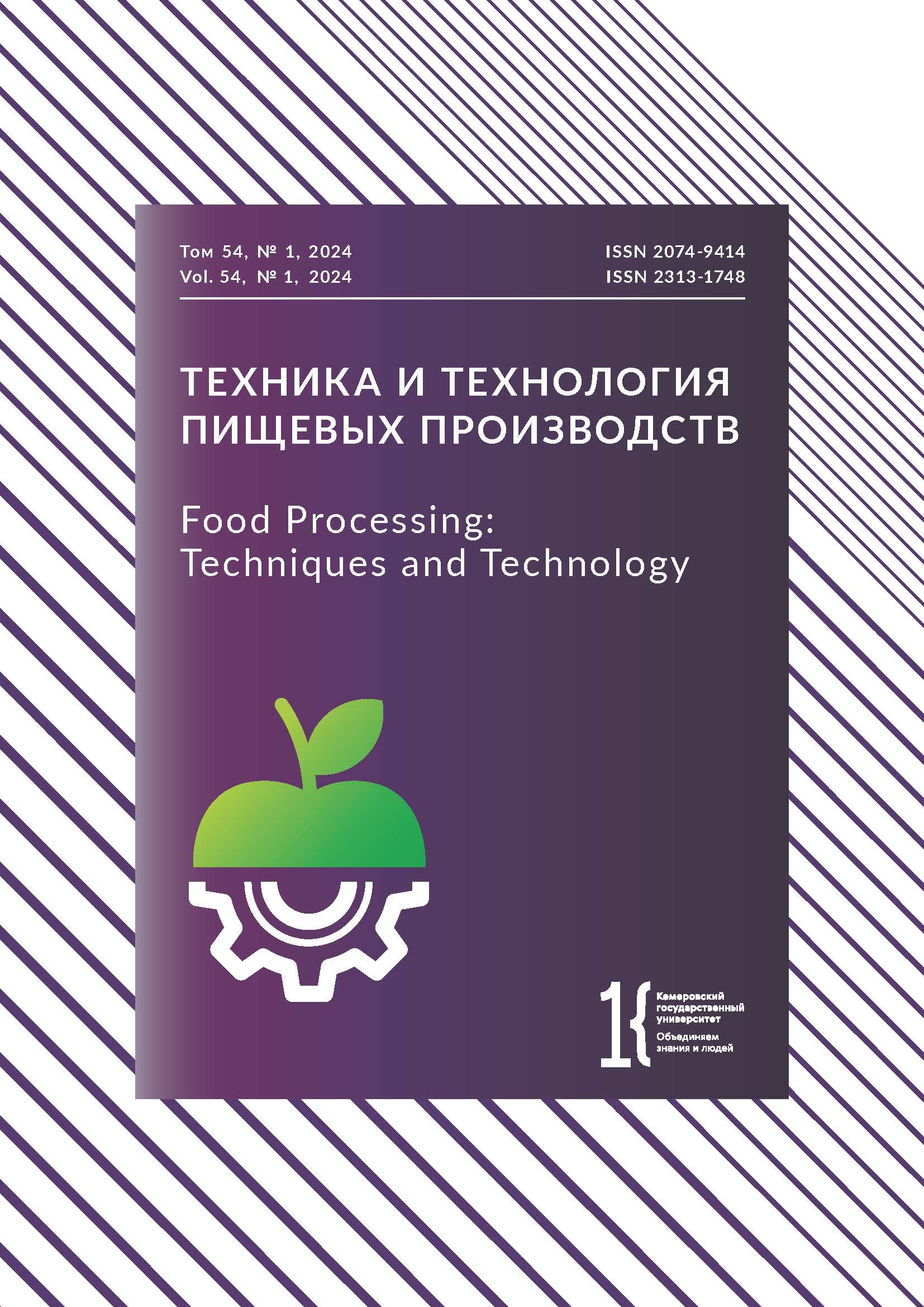Краснодар, Россия
Краснодар, Россия
Краснодар, Краснодарский край, Россия
Новочеркасск, Россия
ВАК 4.3.1 Технологии, машины и оборудование для агропромышленного комплекса
УДК 66 Химическая технология. Химическая промышленность. Пищевая промышленность. Металлургия. Родственные отрасли
В виноделии потерявший товарный вид столовый виноград является отходом производства. Однако его технологические свойства позволяют рассматривать ягоды такого вида и качества как сырье для винных и виноградных спиртов. Цель работы заключалась в исследовании влияния состава и технологии спиртов на легколетучие соединения и органолептические показатели напитков. Объектами исследования являлись напитки из виноградного сырья 6 белых и 6 красных сортов. Остановку брожения осуществляли внесением в опытные напитки винных и виноградных спиртов, полученных ректификацией дистиллятов из столового винограда, а в контрольные – зернового спирта-ректификата. Нормируемые показатели качества спиртов и напитков определяли по стандартным методикам, легколетучие соединения – газохроматографически. Дегустацию проводила дегустационная комиссия ФГБНУ СКФНЦСВВ. Винный и виноградный спирты из столовых сортов винограда не оказали значимого влияния на нормируемые показатели и содержание летучих кислот и ацетоина в напитках. Они увеличили массовые концентрации легколетучих соединений в ряду: напитки с зерновым спиртом ˂ напитки с винным спиртом ˂ напитки с виноградным спиртом. Содержание в напитках ацетальдегида увеличилось на 10–14 %, этилацетата – на 25–35 %, сложных эфиров – на 4,5–8,5 %, высших спиртов – на 15 %. Содержание фурфурола увеличилось в напитках с виноградным спиртом на 0,4–1,4 мг/дм3. В аромате напитков из белоягодных сортов винограда усилилось восприятие цветочно-медовых оттенков, а в аромате напитков из темноягодных сортов винограда – лесного ореха и меда. Винные и виноградные спирты привели к повышению содержания легколетучих соединений в напитках и оказали положительный эффект на их сенсорное восприятие. Это свидетельствует о целесообразности применения в технологии напитков спиртов, произведенных из столового винограда.
Виноделие, напитки, столовые сорта винограда, винные спирты, виноградные спирты, летучие соединения, сенсорные характеристики
1. Levchenko SV, Boyko VA, Belash DYu. Directed formation of commercial quality of table grapes based on the use of foliar dressing with microfertilizers. Magarach. ViticultureandVinemaking. 2020;22(3):225-229. (In Russ.). https://doi.org/10.35547/IM.2020.22.3.008
2. Khalil U, Rajwana IA, Razzaq K, Farooq U, Saleem BA, Brecht JK. Quality attributes and biochemical changes in white and colored table grapes as influenced by harvest maturity and ambient postharvest storage. South African Journal of Botany. 2023;154:273-281. https://doi.org/10.1016/j.sajb.2023.01.044
3. Ricardo-Rodrigues S, Laranjo M, Coelho R, Martins P, Rato EA, Vaz M, et al. Terroir influence on quality of “Crimson” table grapes. Scientia Horticulturae. 2019;245:244-249. https://doi.org/10.1016/j.scienta.2018.10.035
4. Batukaev A, Levchenko S, Ostroukhova E, Boyko V, Peskova I, Probeigolova P, et al. The effect of foliar fertilizing on ecological optimization of the application of fungicides on the productivity and phenolic complex composition of grapes. BIO Web of Conferences. 2019;15. https://doi.org/10.1051/bioconf/20191501012
5. Mansour AEM, El-Shammaa M-S, Cimpoies G, Malaka S, Nagwa Z. Improved method of nitrogen application in the vineyards. Stiinta Agricola. 2011;(2):28-33.
6. Abd El-Razed E, Treutter D, Saleh MMS,El-Shammaa M, Fouad AA, Abdel-Hamid N. Effect of nitrogen and potassium fertilization on productive and fruit quality of “Crimson seedless” grape. Agricultural and Biology Journal of North America. 2011;2(2):330-340. https://doi.org/10.5251/abjna.2011.2.2.330.340
7. Gallo V, Mastrorilli P, Cafagna I, Nitti GI, Latronico M, Longobard F, et al. Effects of agronomical practices on chemical composition of table grapes evaluated by NMR spectroscopy. Journal of Food Composition and Analysis. 2014;35(1):44-52. https://doi.org/10.1016/j.jfca.2014.04.004
8. Troshin LP, Kravchenko RV, Matuzok NV, Kufanova RN. Improvement of the assortment to optimize grape production technology in the Anapo-Taman zone. Magarach. Viticulture and Vinemaking. 2021;23(2):120-124. (In Russ.). https://doi.org/10.35547/IM.2021.23.2.003
9. Bordiga M, Travaglia F, Locatelli M. Valorisation of grape pomace: An approach that is increasingly reaching its maturity - A review. International Journal of Food Science and Technology. 2019;54(4):933-942. https://doi.org/10.1111/ijfs.14118
10. Ferri M, Vannin M, Ehrnell M, Eliasson L, Xanthakis E, Monari S, et al. From winery waste to bioactive compounds and new polymeric biocomposites: A contribution to the circular economy concept. Journal of Advanced Research. 2020;24:1-11. https://doi.org/10.1016/j.jare.2020.02.015
11. Tikhonova A, Ageeva N, Globa E. Grape pomace as a promising source of biologically valuable components. BIO Web of Conferences. 2021;34. https://doi.org/10.1051/bioconf/20213406002
12. Coelho MC, Pereira RN, Rodrigues AS, Teixeira JA, Pintadoa ME. The use of emergent technologies to extract added value compounds from grape by-products. Trends in Food Science and Technology. 2020;106:182-197. https://doi.org/10.1016/j.tifs.2020.09.028
13. Rajković MB, Popović-Minić D, Milinčić D, Zdravković M. Circular economy in food industry. ZastitaMaterijala. 2020;61(3):229-250. (In Serb.). https://doi.org/10.5937/zasmat2003229r6
14. Pakhomova NV, Richter KK, Vetrova MA. Transition to circular economy and closed-loop supply chains as driver of sustainable development. St. Petersburg University Journal of Economic Studies. 2017;33(2):244-268. (In Russ.). https://doi.org/10.21638/11701/spbu05.2017.203
15. Bakhmetov RN, Shelud'ko ON. Comparative analysis of physico-chemical indicators of distillates from yeast sediments and bulk wine. Fruit Growing and Viticulture of South Russia. 2022;(73):321-335. (In Russ.). https://doi.org/10.30679/2219-5335-2022-1-73-321-335
16. Ferreira V, Lopez R. The actual and potential aroma of winemaking grapes. Biomolecules. 2019;9(12). https://doi.org/10.3390/biom9120818
17. Renault P, Coulon J, Moine V, Thibon C, Bely M. Enhanced 3-sulfanylhexan-1-ol production in sequential mixed fermentation with Torulaspora delbrueckii/Saccharomyces cerevisiae reveals a situation of synergistic interaction between two industrial strains. Frontiers in Microbiology. 2016;7. https://doi.org/10.3389/fmicb.2016.00293
18. Wang D, Zhou J, Chen C, Wei D, Shi J, Jiang B, et al. R-acetoin accumulation and dissimilation in Klebsiella pneumoniae. Journal of Industrial Microbiology and Biotechnology. 2015;42(8):1105-1115. https://doi.org/10.1007/s10295-015-1638-1
19. Bovo B, Fontana F, Giacomini A, Corich V. Effects of yeast inoculation on volatile compound production by grape marcs. Annals of Microbiology. 2011;61:117-124. https://doi.org/10.1007/s13213-010-0106-4
20. XiangX-F, LanY-B, GaoX-T, XieH, AnZ-Y, Lv Z-H, et al. Characterization of odor-active compounds in the head, heart, and tail fractions of freshly distilled spirit from Spine grape (Vitis davidii Foex) wine by gas chromatography-olfactometry and gas chromatography-mass spectrometry. Food Research International. 2020;137. https://doi.org/10.1016/j.foodres.2020.109388
21. Perra M, Bacchetta G, Muntoni A, De Gioannis G, Castangia I, Rajha HN, et al. An outlook on modern and sustainable approaches to the management of grape pomace by integrating green processes, biotechnologies and advanced biomedical approaches. Journal of Functional Foods. 2022;98. https://doi.org/10.1016/j.jff.2022.105276
22. Gong M, Zhou Z, Liu S, Zhu S, Li G, Zhong F, et al. Formation pathways and precursors of furfural during Zhenjiang aromatic vinegar production. Food Chemistry. 2021;354. https://doi.org/10.1016/j.foodchem.2021.129503











